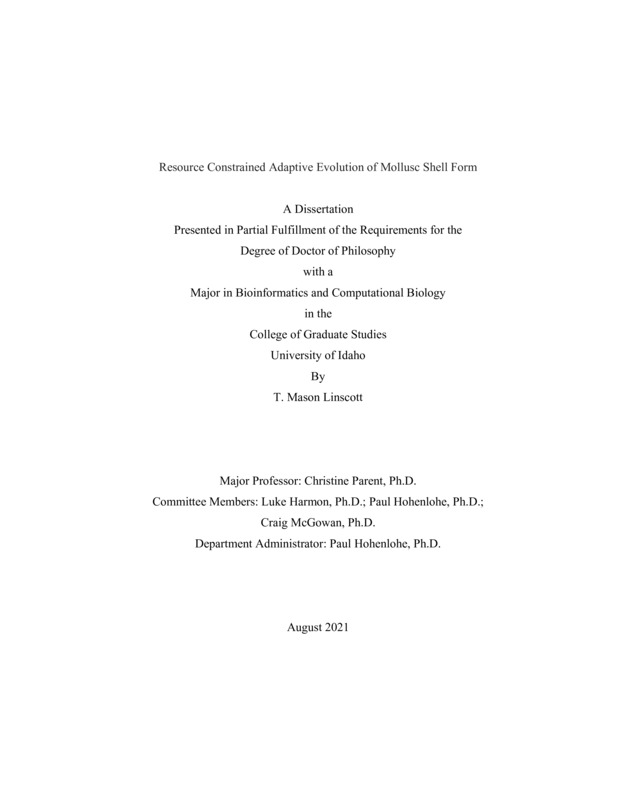Resource Constrained Adaptive Evolution of Mollusc Shell Form
Linscott, T. Mason. (2021-08). Resource Constrained Adaptive Evolution of Mollusc Shell Form. Theses and Dissertations Collection, University of Idaho Library Digital Collections. https://www.lib.uidaho.edu/digital/etd/items/linscott_idaho_0089e_12205.html
- Title:
- Resource Constrained Adaptive Evolution of Mollusc Shell Form
- Author:
- Linscott, T. Mason
- ORCID:
- 0000-0002-6146-7961
- Date:
- 2021-08
- Embargo Remove Date:
- 2022-09-01
- Program:
- Bioinformatics & Computational Biology
- Subject Category:
- Biology
- Abstract:
-
All life has evolved within a set of extrinsic constraints imposed by the environment. Environmental constraints can limit the scope of evolution and distribution of species in predictable ways when taken in the context of intrinsic, genetically coded metabolic mechanisms. For example, species that require a limiting macronutrient for trait synthesis may only express enlarged or elaborate traits in areas or time periods of abundant macronutrient availability. As many functionally important traits for a variety of organisms have been proposed to be modulated by these eco-physiological constraints (EPC), EPCs have been invoked as one of the major driver of historical and contemporary spatial patterns of biodiversity. The study of EPC dynamics entails aspects of physiology, systematics, biogeography, adaptation, and speciation. One approach to characterize how EPCs dynamics may affect diversification is to examine evolutionary and spatial patterns of trait expression in a single system where EPC dynamics are partially understood, and then test for similar spatial/evolutionary patterns across physiologically similar systems. The aim of the present work is to use Mountainsnails (Oreohelix), marine molluscs, and calcium carbonate (CaCO3) availability as a framework to gain a better understanding of how EPC dynamics may affect diversification and species distributions. First, I conducted phylogenetic analyses of Oreohelix to examine how species limits are associated with the evolution of a resource-intensive trait (calcareous shell ornaments). I found that ornamented Oreohelix have evolved recently and that ornamentation is not associated with delimited species units. Second, I utilized species distribution models and shell biometrics to examine whether ornamented Oreohelix are associated with calcareous bedrock and if ornamentation confers greater shell strength. I show that ornamented Oreohelix are generally restricted to calcareous rock environments and stronger than smooth Oreohelix save those smooth forms sampled from calcareous environments. Third, I extend the CaCO3 EPC framework to all marine molluscs and ask whether ornamented marine molluscs are restricted to regions of greater CaCO3 availability and if they will be more greatly affected by future ocean acidification compared to smooth or sea slug molluscs. Ornamented molluscs were found at higher frequency in CaCO3 environments but were shown to be less affected by future anthropogenic ocean acidification compared to smooth forms which are commonly expressed at higher latitudes.
- Description:
- doctoral, Ph.D., Bioinformatics & Computational Biology -- University of Idaho - College of Graduate Studies, 2021-08
- Major Professor:
- Parent, Christine E
- Committee:
- Harmon, Luke ; Hohenlohe, Paul; McGowan, Craig
- Defense Date:
- 2021-08
- Identifier:
- Linscott_idaho_0089E_12205
- Type:
- Text
- Format Original:
- Format:
- application/pdf
- Rights:
- In Copyright - Educational Use Permitted. For more information, please contact University of Idaho Library Special Collections and Archives Department at libspec@uidaho.edu.
- Standardized Rights:
- http://rightsstatements.org/vocab/InC-EDU/1.0/

